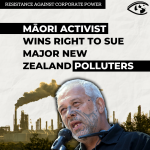Great Lakes Chemical Corporation
Bromide Baron Rap Sheet #2
Address: PO Box 2200, West Lafayette, IN 47906
CEO: Robert B. McDonald
Tel: (313) 497-6100
Fax: (313) 497-6316
Web Site: Great Lakes Chemical Corporation
 Major Businesses: Bromine derivatives including flame retardants and methyl bromide; chlorine; leaded gasoline (through Great Lakes subsidiary Associated Octel) and other petroleum additives; polymer stabilizers.
Major Businesses: Bromine derivatives including flame retardants and methyl bromide; chlorine; leaded gasoline (through Great Lakes subsidiary Associated Octel) and other petroleum additives; polymer stabilizers.
Operations: Plants and facilities in Arkansas, Tennessee, Nebraska, Michigan, Georgia, Florida, Deleware, Belgium, England, Germany,
France, Italy.
Revenues: $2.4 billion in 1995
Profits: $295 million in 1995
Member
: Methyl Bromide Working Group, Methyl Bromide Global Coalition, the European Methyl Bromide Association
The Great Lakes Chemical Corporation, along with Albemarle (a spin-off from the Ethyl Corporation), and a Tel Aviv-based subsidiary of Israel Chemicals called the Dead Sea Bromine Group,
account for roughly 75 percent of global production of methyl bromide. Or, as the Chemical Marketing Reporter puts it, "the global bromine industry is an oligopoly controlled by Albemarle, Great Lakes, and the Dead Sea Bromine Group."[1]
Great Lakes is by far the largest producer of methyl bromide in the U.S., creating more than 40 million pounds annually in its Magnolia, Arkansas plant.[2] Its bromine business has made the company the number one polluter in Arkansas based on the 1994 Toxic Release Inventory data.[3] The company was also fined $190,000 for water pollution in Arkansas in 1994.[4] And Great Lakes was fined $1.3 million for environmental violations in 1991 in Florida alone.[5]
Not Getting the Lead Out
Great Lakes Chemical's involvement in the bromine business -- the primary raw material used for methyl bromide production -- has its roots in leaded gasoline. When tetraethyl lead was invented as a gasoline additive back in the 1920s, it turned out that it left a corrosive byproduct in the engine. The solution that scientists found was to add a chemical called ethylene dibromide (EDB) to the mix.
As leaded gasoline began to be phased out and then banned in many countries, Great Lakes developed international markets for its deadly product. Indeed, today, the only remaining private sector corporation producing and marketing TEL is Great Lakes' subsidiary, Associated Octel.[6] In fact, financial analysts estimate that in 1995, TEL accounted for nearly half of all Great Lakes' profits.[7]
Meanwhile, the globalization of leaded gasoline has made TEL responsible for nearly 90 percent of airborne lead pollution in Third World cities today. What's more, when burned, the EDB in leaded gasoline produces methyl bromide. In fact, the World Meterological Organization has determined that the continuing exhaust from automobiles using leaded gasoline is one of the "three potentially major sources of atmospheric methyl bromide."[8] In other words, in addition to poisoining people, Great Lakes' leaded gasoline destroys the ozone.
The EDB Debacle
With leaded gasoline on its way out in the U.S. in the 1960s, Great Lakes decided to use EDB domestically as a pesticide. Indeed, EDB became Great Lakes' main U.S. product in the 1960s and 1970s.[9] While EDB was used in grain storage silos and applied directly to crops, concerns grew about its toxic impacts. In 1983, the US Environmental Protection Agency banned EDB as a pesticide, finding that it posed an unacceptable cancer risk. As cake mixes, breads and cereals containing EDB residues were recalled from
supermarkets, Emerson Kampen, Great Lakes President at the time, blamed the press. "It was the media that created the problem" he told reporters, "a great product has been taken off the market."[10]
The Bromine Fields
Despite bans on uses of bromine in gasoline additives, pesticides, fire retardants for childrens' pajamas, and fire extinguising halons, Great Lakes Chemicals has continued to pedal bromine-based products, always looking for new ways to make a buck off of bromine. As Kampen puts it, "Bromine still has a great deal of potential for growth."[11] In fact, Great Lakes' bromine production is increasing, with the company investing close to $100
million in bromine and bromine derivatives since the middle of 1993.[12] The company's bromine product line includes flame retardants, drilling fluids, water treatment chemicals, cleaning solvents, glass making, detergents, inputs to pesticides, photographic chemicals and pharmaceuticals such as ibuprofen, and, of course, methyl bromide.[13]
In fact, methyl bromide is a byproduct of a highly profitable brominated fire retardant called tetrabromobisophenol-A (TBBA).[14] Today, demand for TBBA is growing rapidly around the world as computer sales expand. In response, Great Lakes and the other Barons of Bromide are increasing their TBBA production capacity, and with it, the amount of methyl bromide they generate. The day that methyl bromide is legally prohibited however, Great Lakes and its cohorts will either have to incinerate it as hazardous waste,
or eliminate methyl bromide production by making what Chemical Week describes as "a small capital investment." However, according to the magazine, "they are loathe to do so because they stand to lose incremental revenue" from methyl bromide sales.[15]
Endnotes
- "Methyl Bromide Bill Riles 'Greens,'" Chemical Marketing Reporter, Vol. 248, No. 1, July 3, 1995.
- "Chemical Industry: Methyl Bromide," Chemical Marketing Reporter, Vol. 245, No. 1, January 3, 1994.
- Julian Barnes, "Releasing More Toxics, Arkansas 20th on '94 List," Arkansas Democrat-Gazette, June 27, 1996.
- "Chemical Firm Fined $190,000" Commercial Appeal (Memphis), April 3, 1994.
- "Environmental Damage Costs a Bundle," Orlando Sentinel Tribune, July 17, 1992.
- Great Lakes Chemical Corporation, Annual Report Report, p. 16.
- John Hoffman, "World Bank Seeks a Phaseout of TEL," Chemical Marketing Reporter, May 27, 1996. Kenny Bruno, "Poison Petrol."
- WMO, Scientific Assessment of Ozone Depletion: 1994, Executive Summary, World Meterological Organization, Geneva, 1994, p. 9.
- Anon., "Great Lakes Chemical: An Aggressive Growth Plan Pays Off," Chemical Week, March 21, 1984.
- Anon., "Great Lakes Chemical: An Aggressive Growth Plan Pays Off," Chemical Week, March 21, 1984.
- Elizabeth Kiesche, "Entrepreneurial, Yet Frugal--Great Lakes Defies the Odds," Chemical Week, May 6, 1992.
- "Great Lakes to Increase Bromine Output in U.S., U.K.," Chemical Marketing Reporter, Vol. 247, No. 7, February 3, 1995.
- Albemarle Corporation, 1995 Form 10K, U.S. Securities and Exchange Commission, p. 5.
- Ira Breskin, "Bromine Makers Cheer as Derivatives Business Warms," Chemical Week, November 30, 1994, pp. 40-41.
- Ira Breskin, op. cit..
- 181 Food and Agriculture



